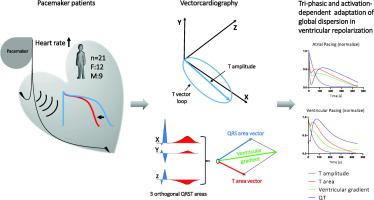Journal of Electrocardiology ( IF 1.3 ) Pub Date : 2021-07-27 , DOI: 10.1016/j.jelectrocard.2021.07.016 Karl-Jonas Axelsson 1 , Lennart Gransberg 2 , Gunilla Lundahl 2 , Lennart Bergfeldt 1

|
Background
Regional differences in ventricular activation sequence and action potential duration and morphology result in dispersion in ventricular repolarization (VR). VR dispersion is a key factor in arrhythmogenesis. We studied the adaptation of global VR dispersion in humans during normal and abnormal ventricular activation, and the relation to the QT adaptation (hysteresis).
Methods
We measured global VR dispersion as T amplitude, T area, and ventricular gradient (VG), using continuous Frank vectorcardiography, in response to abrupt and sustained atrial (AP) or ventricular pacing (VP) aiming at 120 bpm, in 21 subjects with permanent pacemakers.
Results
Following pacing start, VR adaptation showed an initially rapid and complex tri-phasic pattern, most pronounced for T amplitude. There were major differences in the patterns of VR dispersion adaptation following abrupt AP vs VP, confirming that the adaptation pattern is activation dependent. In response to AP, an instantaneous decrease in VR dispersion occurred, followed by an increase and then a slow decrease, all at a lower level than baseline. In contrast, following VP there was an immediate increase to ~4× baseline in T amplitude and T area (but not in VG), with a subsequent biphasic adaptation lasting longer during VP than AP. The initial rapid changes occurred within the time for QT adaptation to reach steady-state.
Conclusions
Our results corroborate and expand data from animal and invasive human studies, showing similarities of the adaptation pattern on different scales. The initial rapidly changing VR adaptation phase presumably reflects a window of increased vulnerability to arrhythmias.
中文翻译:

人类心率增加期间心室复极离散度的适应:过山车过程
背景
心室激活序列和动作电位持续时间和形态的区域差异导致心室复极 (VR) 的分散。VR 弥散是心律失常发生的关键因素。我们研究了人类在正常和异常心室激活期间全局 VR 分散的适应,以及与 QT 适应(滞后)的关系。
方法
我们使用连续弗兰克矢量心电图测量了全球 VR 离散度,如 T 幅度、T 面积和心室梯度 (VG),以响应突然和持续的心房 (AP) 或心室起搏 (VP),目标为 120 bpm,在 21 名患有永久性起搏器。
结果
起搏开始后,VR 适应显示出最初快速而复杂的三相模式,最明显的是 T 振幅。在突然 AP 与 VP 之后 VR 分散适应模式存在重大差异,证实了适应模式是激活依赖的。作为对 AP 的响应,VR 分散发生瞬时减少,然后增加然后缓慢减少,均处于低于基线的水平。相比之下,在 VP 之后,T 振幅和 T 区域(但不是 VG)立即增加到~4 倍基线,随后的双相适应在 VP 期间持续时间比 AP 更长。最初的快速变化发生在 QT 适应达到稳态的时间内。
结论
我们的结果证实并扩展了来自动物和侵入性人类研究的数据,显示了不同尺度上适应模式的相似性。最初快速变化的 VR 适应阶段可能反映了心律失常易感性增加的窗口。











































 京公网安备 11010802027423号
京公网安备 11010802027423号